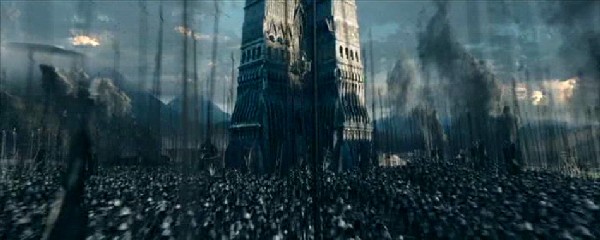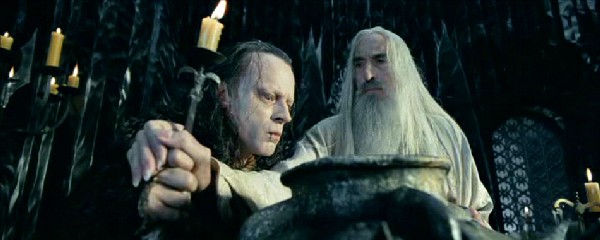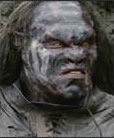3.06.*c. Isengard Unleashed by Figwit

How does it happen in the movie?
We learn bits and pieces of what Saruman is up to in his tower throughout the entire second movie. The most important scene, however, is the one where Saruman shows Gríma his massive army of Uruk-hai waiting to attack Helm’s Deep. In true ‘Triumph des Willens’-style Sharkey gives an impressive ‘search & destroy’-speech, while a completely baffled Gríma stands by and looks.
The scene is reminiscent of the scene in ‘Fellowship of the Ring’ where Saruman sends his Uruk-hai to find the Ring and the halfling carrying it, however, the scale is massive this time, and the stakes are much higher.

How did it happen in the books?
Simple: not.
Tolkien doesn’t pay all that much attention to Saruman throughout the trilogy: he is present in the tale of Gandalf at the council in Rivendell [2.II.], again when Gandalf and Théoden go to Isengard to confront Saruman after the Ents have destroyed it and the Battle of Helm’s Deep was won [3.X.] and at the very end of the journey, when he has escaped from Orthanc [6.VI.] and has set up his own little reign in The Shire. [6.VIII.]
However, because the real villain is quite absent throughout most of the story (Sauron being a big flaming eyeball in faraway Mordor), the filmmakers had to bring Saruman into the spotlights and enhance the conflict in that story line. This causes ol’ Sharkey to appear more regularly throughout the trilogy.
With this in mind, it is remarkably that most of the action during ‘The Two Towers’ is still taken from the book:
– Saruman’s destruction of the forest, as depicted in The Burning of the Westfold, plays a prominent part in the decision of the Ents to attack Isengard and bring it down by force. At one point Treebeard laments the change in the wizard, who used to love walking in the woods but now has ‘a mind of metal and wheels’. [3.IV.]
– Engaging the Dunlendings or Wild Men was also one of Saruman’s smarter moves in the book: their hatred for the Rohirrim, who took their lands with leave of Gondor, had been growing for a long time. In Helm’s Deep, the Wild Men are shown mercy – in the movie however, the Wild Men never make it to Helm’s Deep: they have been replaced by the perfect fighting machine, the Uruk-hai.
– The massive army of Uruk-hai is indeed also described in the books: “We are the Uruk-hai: we do not stop the fight for night or day, for fair weather or for storm. We come to kill, by sun or moon.” [3.VII.] This show of physical prowess, bordering on the eugenic ‘dream’ of a war machine, is echoed in the movies by the Uruk-hai being seemingly unaffected by the rain and the storm. They have come to fight, and fight they will.
However, there is no description of Saruman sending off his troops personally, or no reference made to it. The scene with the speech is based on a similar scene of Adolf Hitler, the leader of Nazi-Germany, speaking to his people in a documentary called ‘The Triumph of the Will’ (‘Triumph des Willens’). This was made by German director Leni Riefensthal, and it is one of the most compelling speeches ever recorded on film. Jackson wanted to create the idea in the mind of the audience that Saruman was much like Hitler: a feared leader who inspired his soldiers to hatred. This contrasts immensely with the two major speeches that need to inspire those fighting on the ‘good’ side of the spectre in ‘The Two Towers’: Aragorn’s words of hope to Théoden at the end of the Battle of Helm’s Deep; and of course Sam’s speech in Osgiliath, meant to keep Frodo going.
Another reference made to Hitler, and solely invented by the scriptwriters, is Saruman’s idea of destroying the world of Man. This is not really Saruman’s aim in the books.
A lot could be said about Gríma’s tear, but it has already been said so I’m simply going to direct those interested in theories about it to a thread in the Movies Forum and an article in The Council Courier.
The biggest change is obviously Saruman’s involvement in the deterioration of King Théoden. In the movies, it is suggested in the exorcism-scene that Saruman in some way possesses Théoden’s body and mind.
In the books however, Gríma Wormtongue played a much more important and active role in keeping the King of Rohan out of the way: through his sly council Théoden has come to believe that he is old and weak, and that he’s better off sitting inside Meduseld than actively taking part in the reign of his kingdom. Gandalf’s cure for Théoden’s problem is rather easy: ‘I bid you come out before your doors and look abroad. Too long have you sat in shadows and trusted to twisted tales and crooked promptings’. [3.VI.]
Mistakes
Borrowed Lines
Bookie Details
– Before Saruman walks over to his balcony with him, we see Gríma lean too close with his candle to a pot. This pot, which can be seen here, contains the gunpowder used for the bomb that will breach the thick wall of Helm’s Deep. Gríma’s unawareness of what it is exactly that Saruman is working on, is a nice nod to the book, where no one seems to know just what it is that destroyed the wall. Aragorn calls it ‘devilry of Saruman’ and ‘the fire of Orthanc’ [3.VII.], suggesting that gunpowder is only used for military purposes by Saruman.
- 3.01.*b. The Burning of the Westfold by Figwit
- 3.07. The Battle of Helm's Deep by atalante_star
- GrÃma by atalante_star
Interesting Links:
Our Gallery has has screencaps of the theatrical version, as well as the extended edition.
A transcript of 'The Lord Of the Rings: The Two Towers' can be found in our Film Fun & Facts section.
A summary of 'The Lord Of the Rings: The Two Towers' can be found in Elrond's Library.
Some articles that are related to this sequence:
- Some more information about GrÃma Wormtongue and Saruman, and another one about his Relation to the One Ring.
- In the Literature Articles section you can find an article about Saruman and Technology.
Forum threads related to this sequence:
- You can discuss this sequence in detail in TTT Sequence by Sequence #9: The Road to Helm's Deep in the Movies Forum, as well as GrÃma's Tear.
Take a look at how some artists saw this part in the book:
- Saruman of Many Colours by John Howe
- Saruman by Alvaro Barros
- An interpretation of Saruman by ncouto
- Uruk-hai by John Howe
- Isengard by John Howe
Looking for something more creative - you may find it here:









